Welcome to Chania in western Crete
Chania, Crete
Welcome to this romantic harbour city in western Crete, with a touch of Venice.
Although the peaks of the 2,000 m high White Mountains are just a few kilometres as the crow flies from the centre of Crete’s second largest city, this metropolis in western Crete seems to have its focus directed entirely towards the Aegean.
A car-free promenade lines the huge harbour basin dating back to Venetian times. Not only will you find many cafés and tavernas along the harbour, but also three museums, a mosque, and large, still partially intact shipyards. The Venetians had their galleys built and repaired here, and stored their vessels here over winter. Today, the harbour is heavily silted up. Ferries and cargo ships can no longer enter, only yachts, excursion boats and fishing boats lie at its quays.
It all begins right behind the waterfront promenade: the maze of alleyways through the mostly pedestrianised historic centre. Old city palaces and towering historical tenement houses line the often slightly crooked streets. Many artisans and sophisticated boutiques have established themselves in the historic centre, and in the romantic ruins of century-old Venetian houses, some open to the sky, Cretan musicians play the night away as you dine.
The Archaeological Museum is housed in an old Catholic church, and another church is probably the only one in the world to have both a Christian bell tower and a Muslim minaret.
It all begins right behind the waterfront promenade: the maze of alleyways through the mostly pedestrianised historic centre. Old city palaces and towering historical tenement houses line the often slightly crooked streets.
The inland side of Chania’s historic centre is still nearly completely surrounded by its medieval walls. You can even walk along certain sections. The new town extends on the other side of these walls, but as a tourist, it’s really not a must-see. Only the city park with its excellent coffee house and a summer cinema is very much worth a visit here.
The most beautiful sight is the view of Chania from the water. To enjoy it, you have two options: either you walk out along the long harbour pier, or you take a short boat trip out to sea. Then you, too, are sure to be impressed by the beauty of the old city, set against the backdrop of orange groves and high mountains.
A Day in Chania
A Tour of the Historic Centre
Open our recommended tour through Chania in Google Maps
1 Market Hall
It’s only about 40 minutes by public bus from Georgioupolis to Chania. The bus station is situated in the new town, about 10 minutes from the Market Hall, where the new and old towns meet. Starting from the bus station, simply turn right onto the wide Kidonias road and follow it to the end. Then take a left onto Odos Apokoronos street - and already you’ll be standing in front of the beautiful building. The hall is over 100 years old, and although it has mostly given up its actual purpose as a central market for the locals, a short stroll through the cross-shaped aisles is still worth it. In particular, you can purchase herbs, honey and other Cretan cuisine here and are certain to get a good cup of coffee.

2 The church of Agios Nikolaos - Old Town District of Splantzia
Leave the Market Hall via the northern exit, then go right along Odos Tsouderon street and after two minutes turn left onto Odos Daskalogianni street. It will take you to the popular Platia 1821. The church of Agios Nikolaos is situated here. It has been through a very checkered history: it was first a church, then a mosque and now a church again. Its façade reflects its past: to the left, the façade is flanked by a church tower, to the right by a recently restored Ottoman minaret. You’re not likely to find that anywhere else in the world.
The historic quarter of Splantzia extends between the church and the harbour. This district in particular has retained its original, historic features. Simply criss-cross through the narrow alleyways here all the way down to the water. Once you arrive at the shore, take a right and head out onto the pier It’s 600 m long, and you can go as far as you like, but at the end the Venetian Lighthouse awaits you.

3 Harbour Promenade: Venetian Shipyards and the Great Arsenal
The Firkas Fortress guards the other side of the harbour entrance. It marks the end of your walk, which now simply takes you along the harbour. First, though, you should take a break in the Lounge Caffé of Chania Yacht Club. Take a peek inside, even when the sun is shining, because inside you’ll be sitting in the hall of an old, exquisitely restored Venetian shipyard. Cretan herbal teas are sweetened here with honey and can also be seasoned with Greek saffron on request.
The hall of another medieval shipyard is just 25 metres down from the Lounge Caffè, with a seaworthy replica of a Minoan ship inside. It was with small vessels such as these that the Cretans crossed the Eastern Mediterranean and the Aegean Sea 3,500 years ago. And with this replica, they sailed from Crete all the way to Piraeus just a few years ago. No fear!
Now follow the harbour promenade to view other Venetian shipyards. Some are now used as workshops and store houses. Directly after them looms the Great Arsenal, the weapon storehouse and armoury of the Venetians. It was wonderfully restored in 2002. Today, it houses the Mediterranean Architectural Center with interesting temporary exhibitions. The next building worth seeing on the waterfront is the striking Yiali Tzami Mosque from the year 1645. Horses and carts wait here to take guests on tours of the city, small excursions boats are docked by the quays, waiting to whisk you away to sea for half an hour.
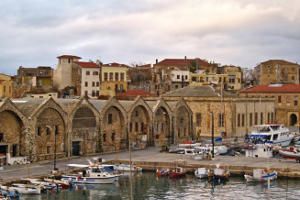
4 Harbour: Yiali Tzami Mosque in Chania, Café and Taverna district, Firkas Fortress
The café and taverna district of the port really starts at the Yiali Tzami Mosque. Stroll past all the pubs to Firkas Fortress with the Nautical Museum, thematically dedicated to Greek maritime history and also to the German occupation during the Second World War. Two cafés entice you to take a break with beautiful harbour views right in front of the entrance to the fortress.
From the entrance to the fortress, take the narrow alleyway Odos Angelou sloping gently uphill and then turn to the left onto the arrow-straight Odos Theotokopoulou street. It later becomes Odos Zambeliou street. On both streets, you will find numerous charming shops and small restaurants. At the end of Zambeliou street you will arrive at Platia Santrivani square, which goes down to the water. Here, turn right into Odos Chalidon street and first pay a visit to the Archaeological Museum in a Gothic church, before it closes at 3 pm.
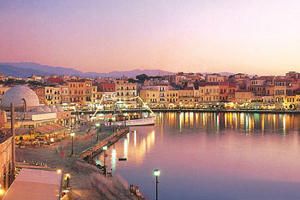
5 Old Town: Synagogue, Schiavo Bastion, leather shops
Then, it’s finally time for a late lunch. Perhaps you've already spotted a restaurant on the way that you’d like to return to. You’re sure to find something in the immediate surroundings on Platia Santrivani, whether you want a hearty meal, or just a small snack. Afterwards, go back a short distance on Odos Zambeliou street and take the second street on your left, Odos Kondilaki. A small sign will point out the Etz Hayyim Synagogue to you, which is open to visitors. At the end of the alley, you can go up the Schiavo Bastion. From this medieval bastion you have views overlooking most of the historic centre. Once you’ve descended again, turn left, and you are back in Odos Chalidon street, which was where you’ve already seen the Archaeological Museum. Now take a right, and shortly afterwards, turn into Odos Skridlof street, where the city’s leather shops are concentrated.
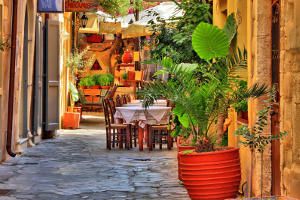
6 City Park
Odos Skridlof street takes you back to the Market Hall. If you’re still up for more, head to the City Park on the broad Tzanakaki street to finish off your tour. It’s barely 10 minutes’ walk away. You can see impressive specimens of the Cretan wild goat in enclosures, and benches are positioned in the shade beneath trees from all over the world. The highlight of the Park is its traditional coffee house "O Kipos", where they still serve your Greek mokka in a traditional copper pot. Choose between Oriental cakes, such as Kataifi and Baklava, and gâteaux. Maybe you can also give the glyka koutaliou a try: fruit and vegetables preserved in syrup. But even if you’re more in the mood for champagne, you will find it here.
It’s 10-15 minutes’ walk from the City Park back to the bus station. If you’d also like to watch a screening in the City Park summer cinema, then you will need to take a taxi back to Georgioupolis…
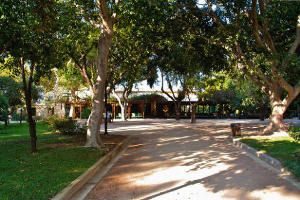
Museums of Crete
Archaeological Museum in Chania
Open the Archaeological Museum Chania in Google Maps
No museum in all of Crete has a more beautiful building than this: the gothic-style former Venetian Monastery of Saint Francis. It is home to some of the items that archaeologists have found in Chania and the surrounding area in the last 100 years. The unique ambience of this archaeological museum is enhanced by the small outer courtyard, which was formerly part of the cloister. You should allow at least 30 minutes for a visit to the museum.
A clay sealing dated to the second half of the 15th century B.C. is practically sensational. It is on display in showcase 10 on the first left-hand pillar of the central nave. Incidentally, it also decorates the front and back cover of the museum prospectus, which you will receive for free at the admissions desk. This clay sealing depicts a collection of multi-story Minoan buildings with two gates, crowned by the horns of a bull. It looks like a small city. Archaeologists conjecture that this is a representation of Minoan Chania, which occupied the low hill right by the harbour.
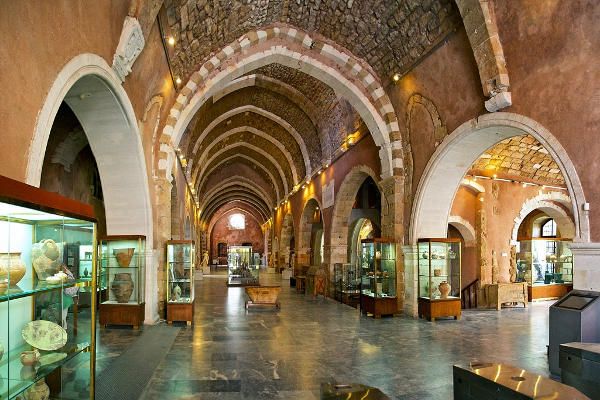
Various other sealings with different motifs are on display below this one, in the same cabinet, including what seem to be almost modern depictions of humans and animals. One very special item is an 8 cm long clay wedge with 12 seal impressions, which probably once enclosed a particularly large parchment scroll.
In the middle of the nave, 60 clay bull figurines will capture your attention. They date from the period between about 400 B.C. and 200 A.D., vary in size, and would originally have been painted. They were found in a sanctuary of Poseidon in western Crete, where the god of the sea was worshipped in particular as the god of fertility and as the Earth-Shaker who sent earthquakes. The bull statuettes were offerings that the people were gave in lieu of expensive living bulls, or in memory of a bull sacrifice that had in fact been made.
The floor of the rear central nave is covered with Roman mosaics from the 3rd century. They were uncovered close to the Market Hall in Chania. One shows how the god Dionysus, accompanied by a satyr, finds Ariadne asleep on the beach of Naxos. The four seasons are personified in the corners. The rectangular outer panels display scenes and figures from comedies by a particularly popular Greek dramatist at the time, Menander. A second mosaic, only partly preserved, shows Dionysus riding on a panther, and a third shows Amymone being attacked by a satyr, and the god Poseidon coming to her rescue. Above it is a lovely little mosaic showing a cockfight.
Info: Odos Chalidon 25, Old Town of Chania, Tel. 28210 90304, open April - October daily 8 am - 8 pm, November - March Tuesday to Sunday 8 am - 3 pm, Entrance 4 euros, school-age pupils free, students and senior citizens aged 65 and over 2 euros. From November to March, free admission for all every first Sunday of the month.
For more information, see the Archaeological Museum in Chania website.
Museums of Crete
The Nautical Museum in Chania
Open the Nautical Museum Chania in Google Maps
The only maritime museum on our island is in the conspicuous, dark-red building at the western end of the harbour. Here you will see a number of things which can give you a better understanding of historic Chania. If you concentrate on the major exhibits in this two-storey building, you need little more than half an hour for your visit.
Hall II on the ground floor houses a very vivid model of a Venetian galley from the 16th century. It was with ships such as these that the Venetians crossed the Mediterranean Sea, and these ships were also berthed in the harbour of Chania. Their sails were only set in favourable winds. Their 'motor' was composed of 220-260 galley slaves. They sat on long benches on the open deck, exposed to the wind and weather. Often, they were even chained and were driven to pull harder by the lashes of a whip. Usually they had been overpowered by the Venetians on their raids, or bought at the slave markets on the Mediterranean. The main weapon on board was the long naval ram on the bow. There were only very few canons. They were installed just before clashing with the enemy and usually fired to the front.

The Venetians safely stored their ships in large shipyards right by the docks for winter, with its occasional storms and high seas. There were 17 or 18 of these shipyards in Chania. Seven are still preserved, and you can see them on your tour of the city. The model of a Venetian shipyard iin Hall II shows one of them in its original state.
Prior to visiting the museum, you will have already seen something of Chania. You will now also easily recognise some of the features on the scale model of the late medieval city (1:500) in Hall II.
If you are interested in ancient history, or simply paid attention in history class at school, then Hall IV on the ground floor will be of particular interest to you. Here, the events of great historical naval battles are explained with the aid of models. Free explanative leaflets in English are also available.
You might want to limit yourself to studying the most important of these battles: The Battle of Salamis in the year 479 B.C. At that time, the Persians were threatening Athens, and in turn all of Greece, and ultimately even Europe as a whole. The Hellenes had already been defeated on land, and the Persians had destroyed the Athenian Acropolis. This naval battle would be decisive. The Athenians and their allies forged a brilliant plan. They lured the Persians into a narrow strait between the Attic mainland and the off-shore island of Salamis. There, they attacked them with small, highly manoeuvrable ships and boldly routed the Persian ships. Athens and western civilisation were saved...
An exhibition on the first floor tells of another battle, which particularly affected the war effort in World War II. Numerous photos, newspaper clippings and military maps exactly describe the events of the Battle of Crete in 1941 and the subsequent German occupation of the island. Uniforms and the equipment of soldiers and partisans complement this very informative and factual exhibition. It offers an unbiased depiction of events.
For more information, see the Nautical Museum in Chania website.
Museums of Crete
The Minoan Ship of Chania
Location of the Minoan Ship in Google Maps
The wealth and prosperity of Crete in the 2nd millennium B.C. was based not only on the fertility of the island, but also on intense trade operated by the Minoans in the eastern Mediterranean. But what did their ships look like? So far, not a single wreck of a Minoan ship has been found, only representations of them on murals. But you can now see a Minoan ship - in a Venetian shipyard at Chania harbour!
This ship demonstrated its seaworthiness in the Olympic year of 2004. With a crew of 12 men and women, it left the port of Chania on May 29th. It stopped off at the Rodopos Peninsula in Crete, the islands of Antikythira and Kythira, the Peloponnesian ports of Monemvasia and Kyparissi, then the islands of Spetses, Hydra and Poros, Methana on the Peloponnese and finally the island of Aegina. On the 24th of June, it reached its destination: the Athenian port city of Piraeus. In a total of ten days, it had travelled 210 nautical miles. With oars alone it managed 2.4 nm/h, with oars and the aid of sails, 3.2 nm/h. The weather played along: the wind never blew more strongly than 3 on the Beaufort scale.

The development of this experimental ship began in 2001. Greek nautical archaeologists and other scientists assumed that the Minoan ship was the further development of a raft such as the one built by Thor Heyerdahl. They had to consider how the Minoans managed to turn a very flat vessel into a semi-cylindrical, seaworthy hull. They first developed their ideas with the help of 3-D animations on the computer and then finally had a model made on a scale of 1:5.
The keel was laid, or in other words, construction of the ship itself began in December 2002. The scientists worked together with boat builders from a traditional Cretan boatyard. A 22 m long cypress trunk was bent to form the keel. The cypress boards that were intended to form the ship's hull were laid out flat next to the keel to begin with.
Then construction began, step by step. The boards were held together with ropes and wooden pegs. Once the shell had been erected, the entire structure was reinforced by cross-beams and finally the ship’s sides were braced with two bent cypress trunks. The boards were sealed against sea water with several coatings of natural paint, and towels soaked in grease and tree resin. On the 1st of December 2003, the ship was launched.
You can walk around the ship in the exhibition in the shipyard in Chania, and take a look from above. You will see lots of photos of the construction process and the basic tools used to build the ship. Moreover, you can also watch a video about the trip from Chania to Piraeus. Afterwards, you will be glad that we no longer need ships like that to get to Crete!
The Venizelos Tombs near Chania
Open the Venizelos Tombs in Google Maps
High above Chania, on the approach to the Akrotiri Peninsula, the Cretan statesmen Eleftherios and Sofoklis Venizelos (1864-1936 and 1894-1964) lie buried. The tombs of father and son are embedded in the pavement on a large terrace in front of a little church dedicated to the prophet Elijah. The far-reaching view from the beautiful park with a small pine forest stretches far beyond Chania, all the way to the White Mountains and along the coast right up to the Rodopou Peninsula.
In his day, Eleftherios Venizelos had expressed the desire to be buried here: on this spot in January 1897 the Greek flag was flown during the last rebellion against Ottoman rule, which he led. Shells from European battleships blew apart the flag pole.
Thereupon the Cretan Spiros Kayales took the flag in his hands and raised it himself, turning his body into a flagpole. In response, the Europeans ceased fire. In 1997 a monumental bronze statue was erected to this 'Hero of Akrotiri', which can be seen for miles around and is now just a short walk from the tombs. A shell from a Russian battleship also hit the old Church of Elijah. It is a belief held by many Cretans that it was no coincidence that, later, there was a fatal explosion on board the ship...
The inscription on the Venizelos Tomb is a quote from a speech made by Eleftherios Venizelos:
Dear friends, the deceased laid to rest here was truly a man of great courage, with great faith in himself and in the people over whom he ruled. He may have had his shortcomings, but he was never short of courage and he never abandoned himself to fate, because he would not allow that fate determined the destiny of his country. On the contrary, he built on all the fiery passion he held within, on his intellectual and physical strength...

Discover heavenly Crete for yourself
An island full of surprises
A holiday destination for bathing enthusiasts, nature lovers, hikers, and those interested in history and culture. Today, Crete is one of the most popular tourist destinations in the Mediterranean - cosmopolitan yet mysterious.
Popular hotels on the sandy beach
The Corissia Hotels are situated within the tranquil, picturesque village of Georgioupolis right on the sandy beach. An ideal seaside resort both to relax and explore the island, because that is just what holidays on Crete are all about.
Let yourself be pampered
 OUR BEST
OUR BEST